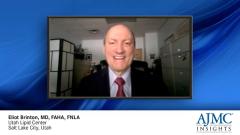
Drivers of Health Care Utilization in Patients with HoFH
Key opinion leaders discuss drivers in health care utilization for patients diagnosed with HoFH.
Episodes in this series

Eliot Brinton, MD: Homozygous FH [familial hypercholesterolemia; HoFA] is really 1 of the most severe diseases anyone treats in any specialty because of the life-threatening complications patients have very, very early in life. These are the classic cardiovascular diseases; heart attack/stroke that occurs in older ages and people with mild hypertriglyceridemia, and middle-aged folks with [HoFA]. You can have somebody with [HoFA] survive into middle age, but they will usually have these events occurring at or before young adulthood. Really, very early. A couple of things that are unique to [HoFA] is aortic valve disease. You almost never see that in [HoFA]. Virtually, never. It’s really much of a consequence of nonmonogenic hypercholesterolemia. It is seen very commonly in patients with [HoFA] and can present in childhood. You can see somebody needs 3 or 4, or 7, or whenever with some aortic valve stenosis. If left untreated, it can become very severe and life-threatening. There’s one other situation that is a little bit related to FH, but primarily different, and that’s elevated levels of lipoprotein LPL A [lipoprotein A], which will also cause erratic bowel stenosis. Generally, not in young childhood, but it certainly can in adulthood, and even young adulthood. You have some things that are typically adjusted much earlier in life; you have some things that are relatively unique to [HoFA] with possible other few exceptions. But they also tend to happen much earlier. [HoFA] is really so severe and very intensive in terms of cost. Hospitalizations, hopefully, you don’t go there, but hospitalizations for cardiovascular complications are definitely a part of the mix. The treatments do not require hospitalization, although there’s 1 treatment we’ll talk about in just a minute that requires an in-clinic treatment process. There’s a lot of expense on the side of pharmaceutical treatment or medications.
Seth Baum, MD: There’s a tremendous utilization of health care resources for these patients. And it’s very onerous. It’s onerous on the families and the patients and obviously on our health care system but if some of this could be avoided, that would be wonderful. The therapeutics should not be avoided; they should be used, and frankly, should be used even more than we’re currently using. So, everything from doctors’ visits to utilization of multiple medications, this is an ultrarare disease occurring with a prevalence of about 1 in 250,000. So there are some ultrarare therapeutics available that could be costly. If we don’t treat adequately, and sometimes even if we do treat adequately, if patients have events such as heart attacks or acute coronary syndrome and require interventions, require bypass surgery, or have strokes, there is tremendous resource utilization in that regard.
Erin Michos, MD, MHS: Unfortunately, we’re diagnosing [HoFA] too late. There was 1 recent large registry from around the world where the average age of diagnosis was age 12. And we know that the onset of atherosclerotic cardiovascular disease and [HoFA] can be seen and an average age of 8 years of age. So, on average patients with HoFA may be missing up to a decade or more of not getting adequate therapy or delayed therapy. So, we’re often diagnosing too late, which means by the time they are lucky to make it to adulthood. They often have many complications related to this atherosclerotic cardiovascular disease, aortic stenosis and so 1, there’s increased health care utilization from the complications of having atherosclerotic cardiovascular disease. In terms of interventions, coronary revascularization procedures, stents, bypass treating stroke, treating peripheral arterial disease, this can be quite devastating as well as, treating aortic stenosis and in addition, requires multiple medications. We’ve talked about statins and acetamide, which have some efficacy although limited efficacy in patients with HoFA as well as PCSK9 [proprotein convertase subtilisin-kexin type 9] inhibitors. The issue is a lot of those medications require functional LDL receptors, they work by upregulating the LDL receptors and many or most patients with homozygous abate either have defective LDL receptors if not completely null. That’s where we need to move into some of these other therapies that are costly. Lipid apheresis has FDA approval for [HoFA], but this requires patients to come in every 1 to 2 weeks to get their apheresis and this is a service that’s not readily available in a lot of parts of the country. So many patients have to travel quite far to be able to access an appraisal center and then, if they’re coming in every 2 weeks and getting venous access for this procedure this is costly and time-consuming. The good news is we do have some really exciting newer therapies to do offer them. You know, evinacumabwas approved in 2021, in the last year for treatment of [HoFA]. And then the trial of patients with HoFA evinacumab completely reduced LDL by nearly 50% and this was even on top of a background of all the other intensive lipid-lowering therapy. So that’s very exciting news, but this can be an expensive medication costing $450,000 so it can sometimes be challenging to work with payers and get this medication and support medication approved for patients who so desperately need it.
Transcript edited for clarity.
Newsletter
Stay ahead of policy, cost, and value—subscribe to AJMC for expert insights at the intersection of clinical care and health economics.










































